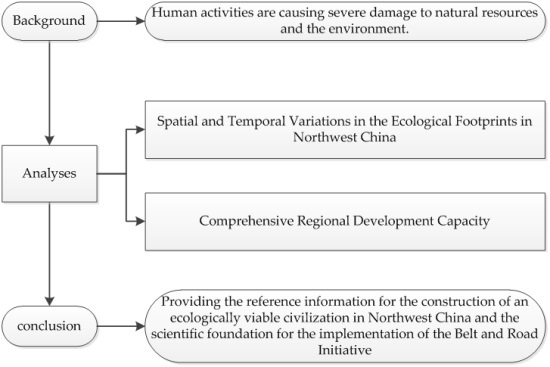Spatial and Temporal Variations in the Ecological Footprints in Northwest China from 2005 to 2014
Abstract
:1. Introduction
2. Data and Methods
2.1. Study Area
2.2. Methods
2.2.1. Ecological Footprint Model Based on NHA
2.2.2. Comprehensive Regional Development Capacity
2.3. Data Sources
3. Results
3.1. Spatial and Temporal Variations in the Ecological Footprints in Northwest China
3.1.1. Spatial Variations in the Ecological Footprints in Northwest China
3.1.2. Temporal Variations in the Ecological Footprints in Northwest China
Dynamic Changes in the Arable Land Ecological Footprints in Northwest China
Dynamic Changes in the Fossil Energy Ecological Footprints in Northwest China
3.2. Analysis of the Overall Regional Development
4. Conclusions and Discussion
4.1. Conclusions
- The ecological footprint in Northwest China was 72,666.92 thousand NHA per year. The average ecological footprints of the provinces in Northwest China range from high to low in the order: Shanxi (22,549.86 thousand NHA) > Xinjiang (19,638.27 thousand NHA) > Gansu (18,548.71 thousand NHA) > Ningxia (7856.87 thousand NHA) > Qinghai (4163.20 thousand NHA). Arable land and fossil energy land account for a large proportion of the total ecological footprint, and are the principal factors contributing to the disparities among the provinces. The ecological footprint for arable land was highest in Gansu and lowest in Qinghai. The ecological footprint for pasture in Xinjiang was significantly higher than that in the other provinces, at 4019.36 thousand NHA. The ecological footprint for fossil energy land was highest in Shanxi, at 12,840.35 thousand NHA, and Ningxia contained the largest proportion of fossil energy land of any province.
- From 2005 to 2014, the dynamic changes in the ecological footprint in Northwest China increased from 57,770.19 thousand NHA in 2005 to 96,501.66 thousand NHA in 2014. The fossil energy ecological footprint increased 34,896.14 thousand NHA which accounted a large proportion for the increase of total ecological footprint. The arable ecological footprint of Gansu decreased each year, decreasing by 1596.61 thousand NHA between 2005 and 2014. That of Shanxi also decreased, at a rate of 231.80 thousand NHA per year. Those of Xinjiang, Ningxia, and Qinghai changed little. However, the fossil energy ecological footprint, which is the major determinant of the ecological footprint, increased from 20,904.76 thousand NHA in 2005 to 55,800.90 thousand NHA in 2014. Each province tended to increase, especially in Shanxi. This indicates that regional economic growth is based on the mass consumption of energy.
- The ecological footprints per 10,000 CNY GDP in Northwest China showed decreasing trends from 2005 to 2014. The ecological footprint diversity indexes were highest in Qinghai, with a range of 1.21–1.30. The development capacity indexes showed that Ningxia had a high value of 1.07 NHA, while Shanxi had the lowest value of 0.58 NHA. In Gansu and Qinghai, resource utilization efficiency, eco-economic system stability, and developmental capacity all increased, indicating that the degree of harmony between the economy and the environment is increasing, which is conducive to sustainable development. In Shanxi, Ningxia, and Xinjiang, resource utilization efficiency and developmental capacity increased, but the stability of the eco-economic system requires further improvement.
4.2. Discussion
Acknowledgments
Author Contributions
Conflicts of Interest
References
- Grimm, N.B.; Faeth, S.H.; Golubiewski, N.E.; Redman, C.L.; Wu, J.; Bai, X.; Briggs, J.M. Global Change and the Ecology of Cities. Science 2008, 319, 756–760. [Google Scholar] [CrossRef] [PubMed]
- Castree, N. Geography and the new social contract for global change research. Trans. Inst. Br. Geogr. 2016, 41, 328–347. [Google Scholar] [CrossRef]
- Reyer, C.; Bachinger, J.; Bloch, R.; Hattermann, F.F.; Ibisch, P.L.; Kreft, S.; Lasch, P.; Lucht, W.; Nowicki, C.; Spathelf, P.; et al. Climate change adaptation and sustainable regional development: A case study for the federal state of Brandenburg, Germany. Reg. Environ. Chang. 2012, 12, 523–542. [Google Scholar] [CrossRef]
- Griggs, D.; Stafford-Smith, M.; Gaffney, O.; Rockstrom, J.; Ohman, M.C.; Shyamsundar, P.; Steffen, W.; Glaser, G.; Kanie, N.; Noble, I. Policy: Sustainable development goals for people and planet. Nature 2013, 495, 305–307. [Google Scholar] [CrossRef] [PubMed]
- Ostrom, E. A general framework for analyzing sustainability of social-ecological systems. Science 2009, 325, 419–422. [Google Scholar] [CrossRef] [PubMed]
- Zhang, Q.; Zhang, L.; Li, Y. Exploring the path of regional eco-compensation under the coordination of man-land relationship perspective. Disaster Adv. 2012, 5, 31–36. [Google Scholar]
- Wackernagel, M.; Onisto, L.; Bello, P.; Linares, A.C.; Falfán, I.S.L.; García, J.M.; Guerrero, A.I.S.; Ma, G.S.G. National natural capital accounting with the ecological footprint concept. Ecol. Econ. 1999, 29, 375–390. [Google Scholar] [CrossRef]
- Costanza, R. The dynamics of the ecological footprint concept. Ecol. Econ. 2000, 32, 341–345. [Google Scholar]
- Wackernagel, M.; Silverstein, J. Big things first: Focusing on the scale imperative with the ecological footprint. Ecol. Econ. 2000, 32, 391–394. [Google Scholar]
- Holden, E. Ecological footprints and sustainable urban form. J. Hous. Built Environ. 2004, 19, 91–109. [Google Scholar] [CrossRef]
- Dakhia, K.; Berezowskaazzag, E. Urban institutional and ecological footprint: A new urban metabolism assessment tool for planning sustainable urban ecosystems. Manag. Environ. Qual. Int. J. 2010, 21, 78–89. [Google Scholar] [CrossRef]
- Rees, W.E. Ecological footprints and appropriated carrying capacity: What urban economics leaves out. Environ. Urban. 1992, 4, 121–130. [Google Scholar] [CrossRef]
- Wackernagel, M.; Rees, W. Our Ecological Footprint: Reducing Human Impact on the Earth; New Society Publishers: Victoria, BC, Canada, 1996; pp. 61–83. [Google Scholar]
- Toth, G.; Szigeti, C. The historical ecological footprint: From over-population to over-consumption. Ecol. Indic. 2016, 60, 283–291. [Google Scholar] [CrossRef]
- Zeng, Z.; Liu, J.; Koeneman, P.H.; Zarate, E.; Hoekstra, A.Y. Assessing water footprint at river basin level: A case study for the Heihe River Basin in Northwest China. Hydrol. Earth Syst. Sci. 2012, 16, 2771–2781. [Google Scholar] [CrossRef]
- Cesaretti, G.P.; Harris, K.T.; Khalil, M.T.; Misso, R.; Osborne-Lee, I.W.; Shakir, H.S.H. Global ecological footprint, climate change impacts and assessment. Rivista Di Studi Sulla Sostenibilita 2013. [Google Scholar] [CrossRef]
- Miao, C.L.; Sun, L.Y.; Yang, L. The studies of ecological environmental quality assessment in Anhui Province based on ecological footprint. Ecol. Indic. 2016, 60, 879–883. [Google Scholar] [CrossRef]
- Wiedmann, T.; Lenzen, M. On the conversion between local and global hectares in ecological footprint analysis. Ecol. Econ. 2007, 60, 673–677. [Google Scholar] [CrossRef]
- Bagliani, M.; Galli, A.; Niccolucci, V.; Marchettini, N. Ecological footprint analysis applied to a sub-national area: The case of the Province of Siena (Italy). J. Env. Manag. 2008, 86, 354–364. [Google Scholar] [CrossRef] [PubMed]
- Kitzes, J.; Galli, A.; Bagliani, M.; Barrett, J.; Dige, G.; Ede, S.; Erb, K.; Giljum, S.; Haberl, H.; Hails, C.; et al. A research agenda for improving national Ecological Footprint accounts. Ecol. Econ. 2009, 68, 1991–2007. [Google Scholar] [CrossRef]
- Li, J.; Liu, Z.; He, C.; Wei, T.; Sun, Z. Are the drylands in Northern China sustainable? A perspective from ecological footprint dynamics from 1990 to 2010. Sci. Total Environ. 2016, 553, 223–231. [Google Scholar] [CrossRef] [PubMed]
- Gao, B.; Xu, Q.T. Dynamic analysis and prediction of ecological footprint in Jilin province of China based on grey prediction model. Mech. Sci. Eng. IV 2014, 472, 899–903. [Google Scholar] [CrossRef]
- Dong, S.; Li, Z.; Li, Y.; Shi, G.; Yu, H.; Wang, J.; Li, J.; Mao, Q.; Huang, Y. Resources, environment and economic patterns and sustainable development modes of the Silk Road Economic Belt. J. Resour. Ecol. 2015, 6, 65–72. (In Chinese) [Google Scholar]
- Fasslabend, W. The Silk Road: A political marketing concept for world dominance. Eur. View 2015, 14, 293–302. [Google Scholar] [CrossRef]
- Zheng, D.; Yin, Y. Eco-reconstruction in Northwest China. In Water and Sustainability in Arid Regions; Springer: Berlin, Germany, 2010; pp. 3–14. [Google Scholar]
- Zhao, H.Y.; Guo, J.Q.; Zhang, C.J.; Sun, L.D.; Zhang, X.D.; Lin, J.J.; Wang, Y.H.; Fang, F.; Peng-Li, M.A.; Liu, C.H. Climate change impacts and adaptation strategies in Northwest China. Adv. Clim. Chang. Res. 2014, 5, 7–16. [Google Scholar] [CrossRef]
- Wan, L.; Xia, J.; Hong, S.; Bu, H.; Ning, L.; Chen, J. Decadal climate variability and vulnerability of water resources in arid regions of Northwest China. Environ. Earth Sci. 2015, 73, 6539–6552. [Google Scholar] [CrossRef]
- Gu, X.W.; Wang, Q.; Liu, J.X.; Li, G.J. New method of urban ecological footprint calculation based on national hectare. J. Northeast. Univ. 2005, 26, 397–400. (In Chinese) [Google Scholar]
- Dai, J.; Wu, Y.; Ouyang, Y. Calculations of the national average yield, equivalence factor and yield factor in ten years based on national hectares’ ecological footprint model—A case study of Xiamen City. In Proceedings of the Geo-Informatics in Resource Management and Sustainable Ecosystem, Wuhan, China, 8–10 November 2013; Bian, F., Xie, Y., Eds.; Springer: Berlin, Germany, 2015; Volume 482, pp. 338–349. [Google Scholar]
- Xu, Z.; Zhang, Z.; Cheng, G.; Chen, D. Ecological footprint calculation and development capacity analysis of China in 1999. Chin. J. App. Ecol. 2003, 14, 280. [Google Scholar] [CrossRef]
- Shannon, C.E.; Weaver, W. The mathematical theory of communication. Q. Rev. Biol. 1951, 5, 3–55. [Google Scholar]
- Ulanowicz, R.E. Growth and Development: Ecosystems Phenomenology; Springer: New York, NY, USA, 1986; p. 203. [Google Scholar]
- National Bureau of Statistics, People’s Republic of China. China Statistical Yearbook (2006–2015); Chinese Statistical Press: Beijing, China. (In Chinese)
- Statistical Bureau of Uygur Autonomous Region of Xinjiang. Statistical Yearbook of Xinjiang (2006–2015); Chinese Statistical Press: Beijing, China. (In Chinese)
- Statistical Bureau of Shaanxi Province. Statistical Yearbook of Shaanxi (2006–2015); Chinese Statistical Press: Beijing, China. (In Chinese)
- Editorial Board of Gansu Yearbook. Gansu Yearbook (2006–2015); Chinese Statistical Press: Beijing, China. (In Chinese)
- Statistical Bureau of Hui Autonomous Region of Ningxia. Statistical Yearbook of Ningxia (2006–2015); Chinese Statistical Press: Beijing, China. (In Chinese)
- Statistical Bureau of Qinghai Province. Statistical Yearbook of Qinghai (2006-2015); Chinese Statistical Press: Beijing, China. (In Chinese)
- National Bureau of Statistics, People’s Republic of China. China Energy Statistical Yearbook (2006–2014); China Statistics Press: Beijing, China. (In Chinese)
- Wu, D.; Liu, J. Multi-regional input-output (MRIO) study of the provincial ecological footprints and domestic embodied footprints traded among China’s 30 provinces. Sust. Use Envir. Resour. 2016, 8, 1345. [Google Scholar] [CrossRef]
- Yue, D.; Xu, X.; Li, Z.; Hui, C.; Li, W.; Yang, H.; Ge, J. Spatiotemporal analysis of ecological footprint and biological capacity of Gansu, China 1991–2015. Ecol. Econ. 2006, 58, 393–406. [Google Scholar] [CrossRef]
- Monfreda, C.; Wackernagel, M.; Deumling, D. Establishing national natural capital accounts based on detailed ecological footprint and biological capacity assessments. Land Use Policy 2004, 21, 231–246. [Google Scholar] [CrossRef]
- Liu, M.C.; Li, W.H.; Zahng, D.; Su, N. The calculation of equivalence factor for ecological footprints in China: A methodological note. Front. Environ. Sci. Eng. 2015, 9, 1015–1024. [Google Scholar] [CrossRef]
- Venetoulis, J.; Talberth, J. Refining the ecological footprint. Environ. Dev. Sustain. 2008, 10, 441–469. [Google Scholar] [CrossRef]
- Siche, R.; Agostinho, F.; Ortega, E. Emergy net primary production (ENPP) as basis for calculation of ecological footprint. Ecol. Indic. 2010, 10, 475–483. [Google Scholar] [CrossRef]
- Gu, Q.; Wang, H.; Zheng, Y.; Zhu, J.; Li, X. Ecological footprint analysis for urban agglomeration sustainability in the middle stream of the Yangtze River. Ecol. Model. 2015, 318, 86–99. [Google Scholar] [CrossRef]
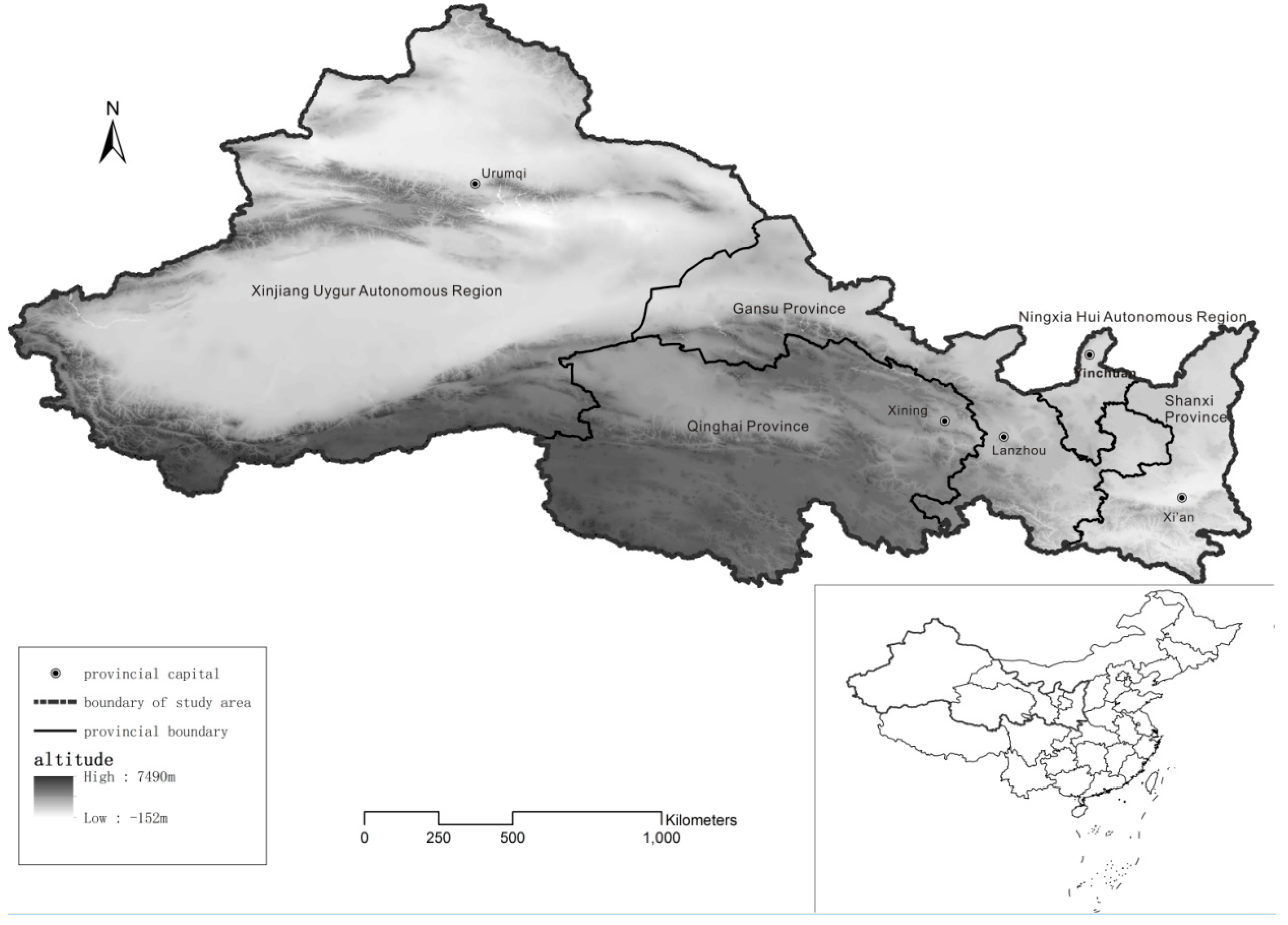
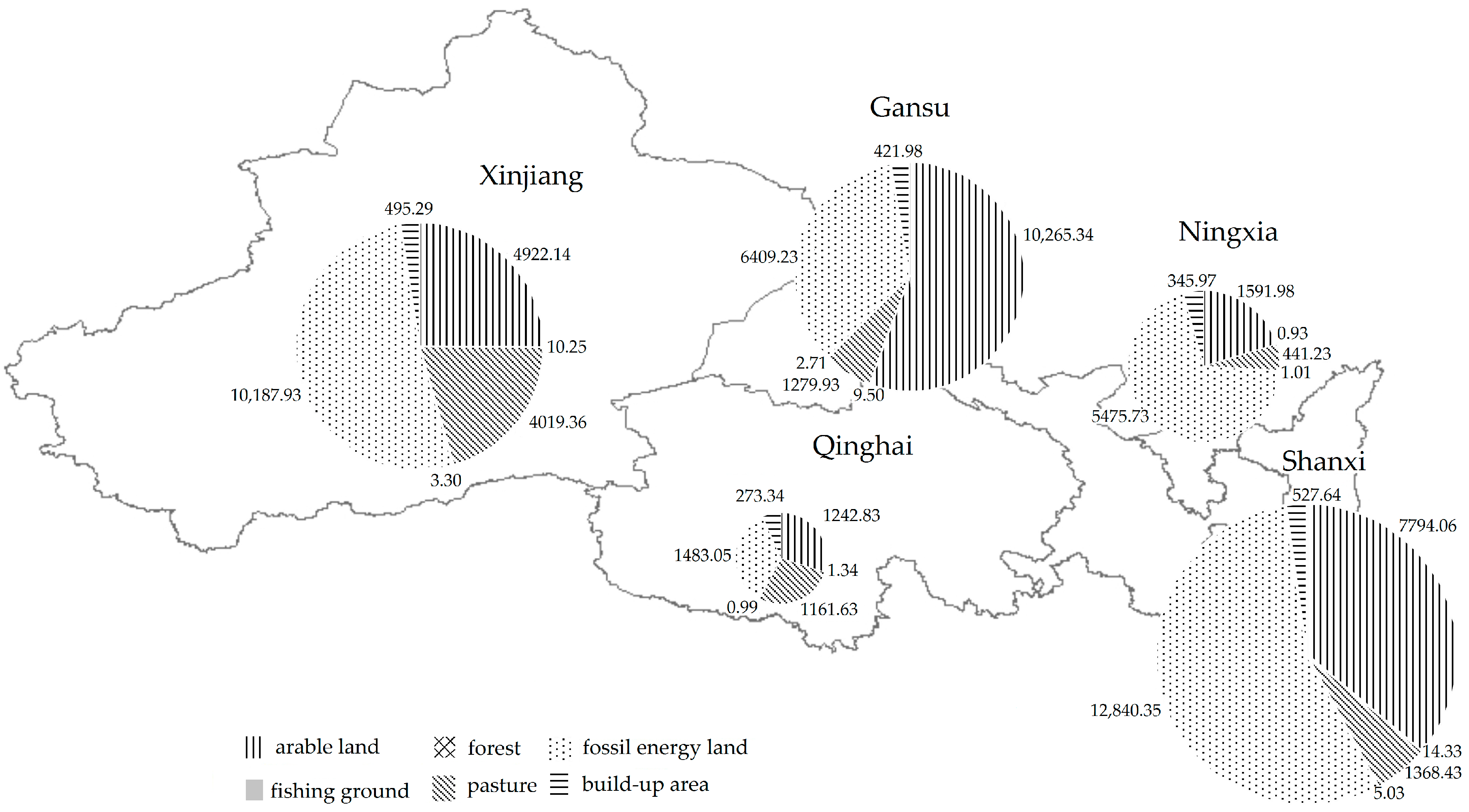
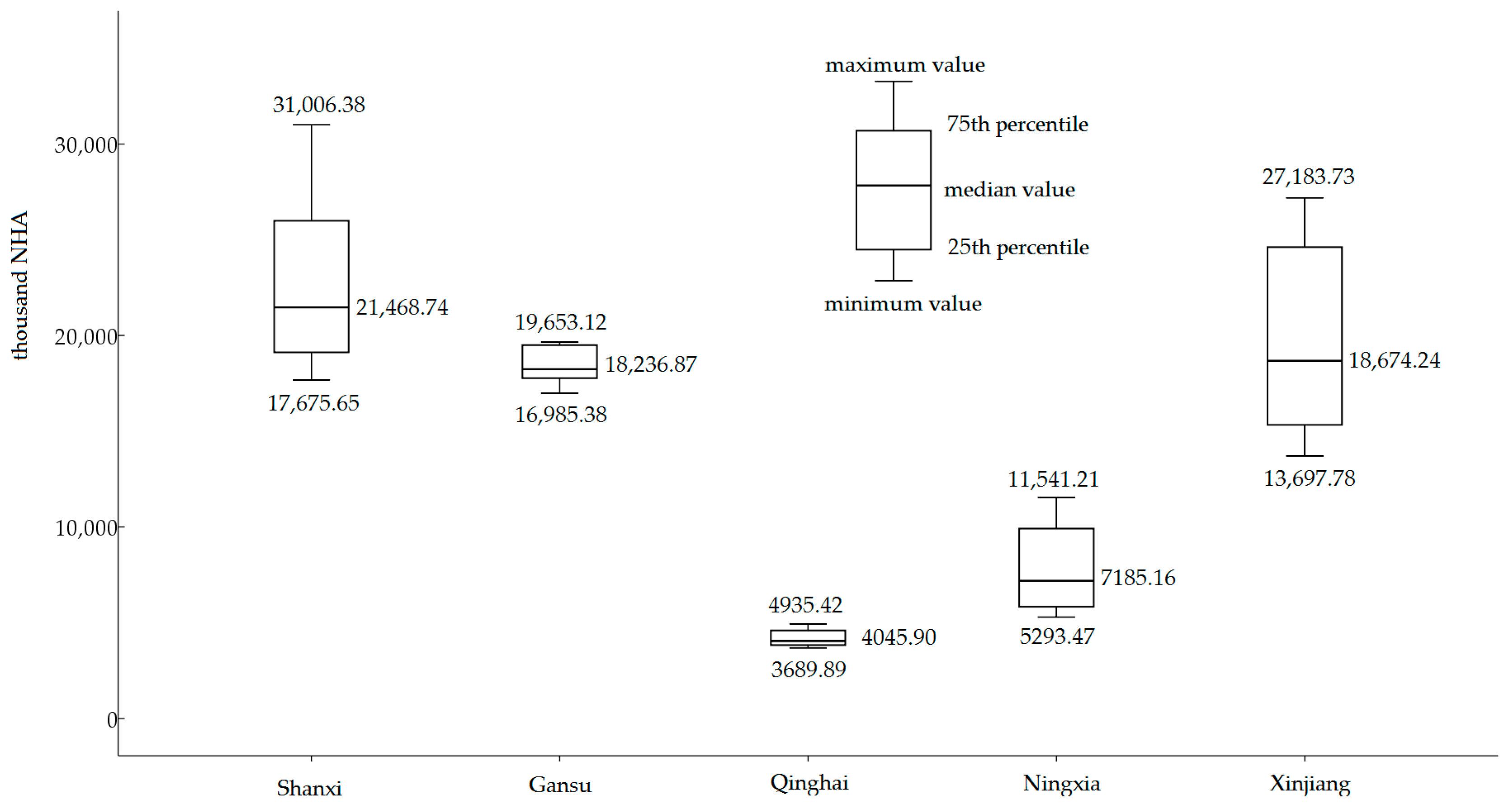
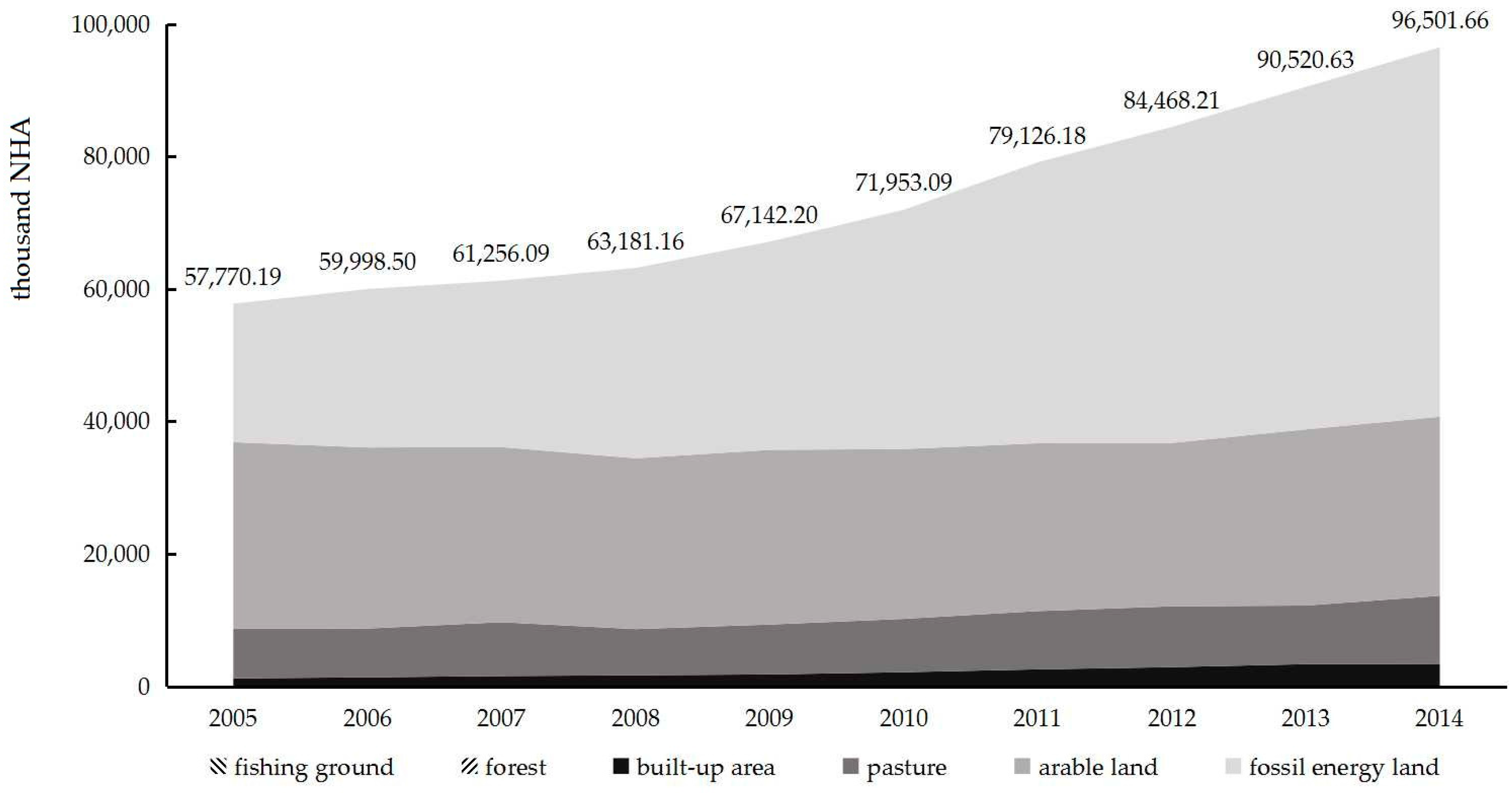
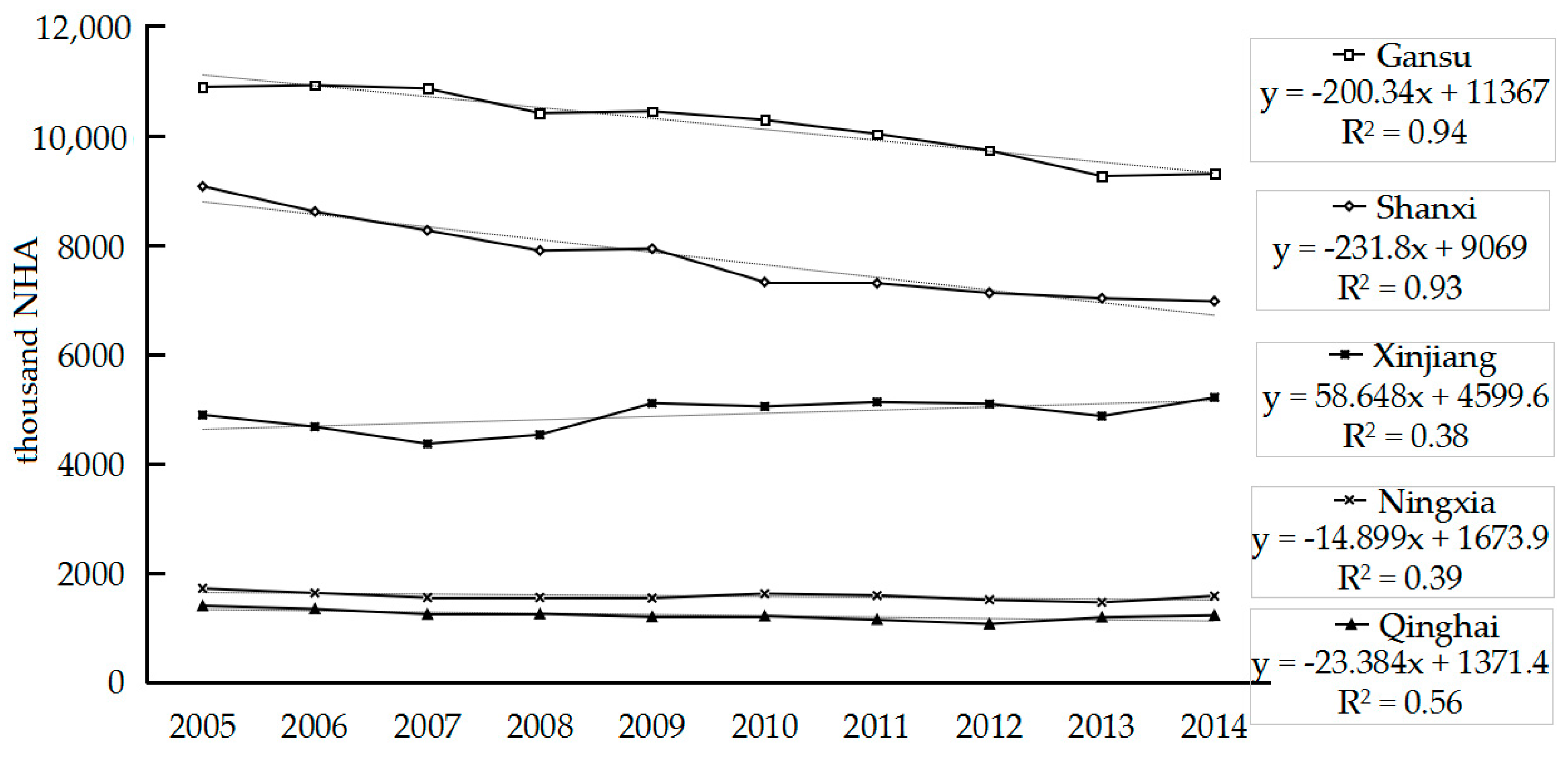

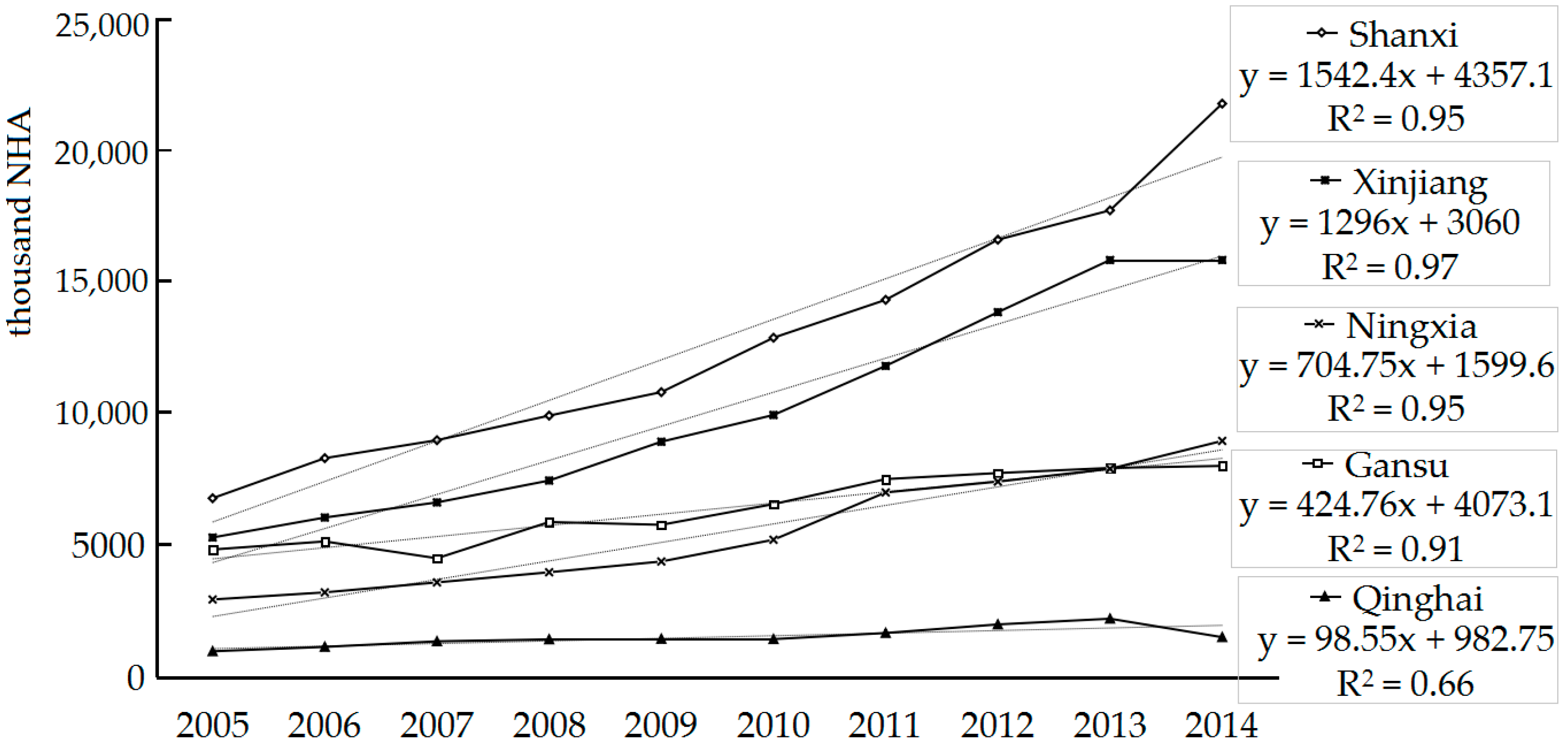
| Land Type | Consumption Item | 2005 | 2006 | 2007 | 2008 | 2009 | 2010 | 2011 | 2012 | 2013 | 2014 |
|---|---|---|---|---|---|---|---|---|---|---|---|
| arable land | grain | 5225 | 5310 | 5320 | 5548 | 5447 | 5524 | 5707 | 5824 | 5894 | 5892 |
| arable land | oil | 2150 | 2250 | 2270 | 2300 | 2310 | 2282 | 2291 | 2296 | 2295 | 2291 |
| arable land | pork | 2915 | 2928 | 2762 | 2896 | 2723 | 2840 | 2844 | 2832 | 2816 | 2825 |
| pasture | beef * | 5.30 | 5.60 | 4.60 | 4.60 | 4.70 | 4.70 | 4.77 | 4.84 | 4.88 | 4.90 |
| pasture | mutton * | 10.00 | 10.80 | 8.80 | 8.70 | 8.90 | 8.47 | 8.69 | 8.89 | 9.05 | 9.14 |
| pasture | poultry | 3387 | 3433 | 3340 | 3578 | 3402 | 3261 | 3292 | 3320 | 3338 | 3364 |
| arable land | eggs | 3137 | 3160 | 3065 | 3296 | 3120 | 3011 | 3039 | 3064 | 3079 | 3101 |
| pasture | milk | 41.00 | 47.60 | 52.60 | 53.00 | 52.50 | 52.70 | 52.73 | 52.64 | 52.69 | 52.69 |
| arable land | beans | 1670 | 1650 | 1460 | 1690 | 1620 | 1638 | 1621 | 1613 | 1607 | 1632 |
| fishing ground | aquatic products | 1481 | 1510 | 1538 | 1495 | 1621 | 1692 | 1760 | 1838 | 1904 | 1998 |
| arable land | vegetables | 31,860 | 35,050 | 35,051 | 35,052 | 35,053 | 35,052 | 35,052 | 35,052 | 35,052 | 35,052 |
| forest | fruits | 16,060 | 16,890 | 17,320 | 17,910 | 18,310 | 18,540 | 19,250 | 19,820 | 20,280 | 19,910 |
| arable land | sugar | 60,420 | 66,750 | 67,650 | 67,440 | 65,170 | 66,753 | 66,753 | 66,529 | 66,301 | 66,584 |
| forest | timber † | 0.32 | 0.38 | 0.40 | 0.46 | 0.40 | 0.46 | 0.47 | 0.47 | 0.48 | 0.47 |
| arable land | peanuts | 3076 | 3254 | 3302 | 3365 | 3361 | 3455 | 3502 | 3598 | 3663 | 3580 |
| arable land | tea | 690 | 720 | 720 | 730 | 730 | 725 | 726 | 728 | 727 | 726 |
| Year | Ecological Footprint Per 10,000 CNY GDP (NHA /10,000 CNY) | Ecological Footprint Diversity Index | Development Capacity Index (NHA) | ||||||||||||
|---|---|---|---|---|---|---|---|---|---|---|---|---|---|---|---|
| Shanxi | Gansu | Qinghai | Ningxia | Xinjiang | Shanxi | Gansu | Qinghai | Ningxia | Xinjiang | Shanxi | Gansu | Qinghai | Ningxia | Xinjiang | |
| 2005 | 0.45 | 0.90 | 0.79 | 0.86 | 0.53 | 0.99 | 0.92 | 1.21 | 1.01 | 1.15 | 0.48 | 0.63 | 0.82 | 0.90 | 0.78 |
| 2006 | 0.39 | 0.78 | 0.69 | 0.74 | 0.47 | 0.98 | 0.93 | 1.23 | 0.96 | 1.14 | 0.49 | 0.65 | 0.84 | 0.86 | 0.80 |
| 2007 | 0.33 | 0.63 | 0.62 | 0.63 | 0.43 | 1.00 | 0.91 | 1.23 | 0.98 | 1.15 | 0.51 | 0.61 | 0.90 | 0.93 | 0.84 |
| 2008 | 0.27 | 0.56 | 0.48 | 0.52 | 0.38 | 0.97 | 0.93 | 1.23 | 0.95 | 1.13 | 0.51 | 0.65 | 0.85 | 0.96 | 0.84 |
| 2009 | 0.25 | 0.51 | 0.38 | 0.49 | 0.42 | 0.98 | 0.95 | 1.24 | 0.94 | 1.11 | 0.54 | 0.66 | 0.86 | 1.00 | 0.93 |
| 2010 | 0.22 | 0.45 | 0.38 | 0.45 | 0.35 | 0.96 | 0.97 | 1.28 | 0.90 | 1.10 | 0.57 | 0.71 | 0.93 | 1.09 | 0.97 |
| 2011 | 0.19 | 0.39 | 0.33 | 0.46 | 0.33 | 0.94 | 1.00 | 1.28 | 0.83 | 1.09 | 0.60 | 0.76 | 0.99 | 1.24 | 1.08 |
| 2012 | 0.18 | 0.34 | 0.28 | 0.42 | 0.33 | 0.91 | 1.00 | 1.26 | 0.80 | 1.08 | 0.63 | 0.75 | 1.01 | 1.22 | 1.19 |
| 2013 | 0.18 | 0.31 | 0.26 | 0.40 | 0.31 | 0.90 | 1.05 | 1.25 | 0.78 | 1.04 | 0.71 | 0.80 | 1.05 | 1.24 | 1.21 |
| 2014 | 0.19 | 0.29 | 0.21 | 0.42 | 0.29 | 0.86 | 1.04 | 1.30 | 0.73 | 1.07 | 0.77 | 0.79 | 1.00 | 1.28 | 1.27 |
| mean | 0.27 | 0.39 | 0.44 | 0.54 | 0.39 | 0.95 | 0.98 | 1.27 | 0.88 | 1.11 | 0.58 | 0.70 | 0.93 | 1.07 | 0.99 |
© 2017 by the authors. Licensee MDPI, Basel, Switzerland. This article is an open access article distributed under the terms and conditions of the Creative Commons Attribution (CC BY) license (http://creativecommons.org/licenses/by/4.0/).
Share and Cite
Yin, Y.; Han, X.; Wu, S. Spatial and Temporal Variations in the Ecological Footprints in Northwest China from 2005 to 2014. Sustainability 2017, 9, 597. https://doi.org/10.3390/su9040597
Yin Y, Han X, Wu S. Spatial and Temporal Variations in the Ecological Footprints in Northwest China from 2005 to 2014. Sustainability. 2017; 9(4):597. https://doi.org/10.3390/su9040597
Chicago/Turabian StyleYin, Yunhe, Xiang Han, and Shaohong Wu. 2017. "Spatial and Temporal Variations in the Ecological Footprints in Northwest China from 2005 to 2014" Sustainability 9, no. 4: 597. https://doi.org/10.3390/su9040597




